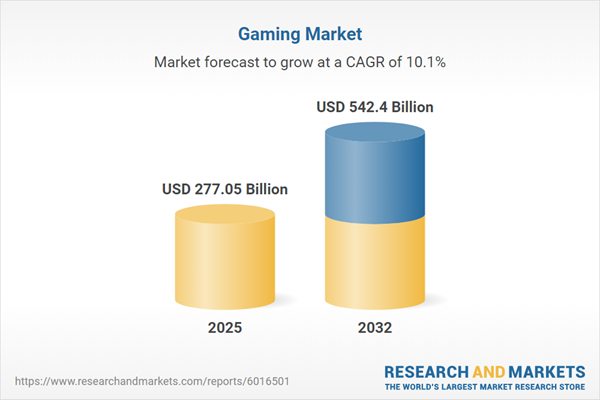Speak directly to the analyst to clarify any post sales queries you may have.
The global gaming market is evolving rapidly, driven by new technologies, shifting business models, and dynamic consumer preferences. Industry leaders aiming to maintain competitive advantage face a complex landscape of opportunities and challenges.
Market Snapshot: The Gaming Market
The gaming market grew from USD 251.89 billion in 2024 to USD 277.05 billion in 2025. With an expected CAGR of 10.06%, the industry’s trajectory points toward USD 542.40 billion by 2032. This sustained expansion underscores the attractiveness of the global gaming sector for enterprises targeting scalable investment opportunities and diversified revenue streams.
Scope & Segmentation: Comprehensive Industry Coverage
- Platform: Cloud gaming (Microsoft XCloud, NVIDIA GeForce Now), consoles (Nintendo, PlayStation, Xbox), mobile (Android, iOS), and PC (Linux, MacOS, Windows) shape the delivery landscape.
- Business Model: Includes free-to-play (advertising, in-game purchases), premium (digital download, retail), and subscription (game pass) revenue structures.
- Genre: Action, adventure, puzzle, role playing (action RPG, massively multiplayer online RPG), shooter (first-person, third-person), simulation, sports (basketball, football), and strategy diversify consumer engagement.
- Distribution Channel: Covers digital download, physical retail, and streaming—each addressing different buyer expectations.
- Device Type: Console, personal computer, smartphone, tablet, and VR headset (both standalone and tethered) reflect the shifting hardware ecosystem.
- Region: Americas (including North America and Latin America), Europe, Middle East & Africa, and Asia-Pacific define major market opportunities and challenges.
- Key Companies: Market analysis features Tencent Holdings Limited, Sony Group Corporation, Microsoft Corporation, Nintendo Co., Ltd., NetEase, Inc., Activision Blizzard, Inc., Electronic Arts Inc., Take-Two Interactive Software, Inc., Bandai Namco Holdings Inc., and Ubisoft Entertainment SA.
Key Takeaways: Strategic Insights for Senior Decision-Makers
- Cloud streaming and subscription models are transforming game development, distribution, and access, facilitating broader device compatibility and user reach.
- Emerging monetization strategies, such as hybrid free-to-play and premium models, are increasing competition for player spending and influencing publisher revenue approaches.
- Advances in AI, augmented reality, and blockchain are opening new paths for content personalization, immersive gameplay, and digital asset ownership within gaming ecosystems.
- Shifting regulatory landscapes and evolving consumer privacy expectations are prompting publishers and technology providers to prioritize compliance and agile market adaptation.
- Regional diversification is critical, particularly as Asia-Pacific and Latin America see strong demand for mobile and cloud-based gaming experiences, while EMEA markets vary by economic maturity and infrastructure.
- Consolidation trends among publishers and cross-industry partnerships with technology firms continue to shape competitive dynamics and innovation capacity.
Tariff Impact: Navigating U.S. Trade Policy Shifts
Forthcoming U.S. tariffs on electronic components and finished gaming hardware are expected to affect production costs and reconfigure global supply chain strategies. Organizations are responding by assessing alternative sourcing regions, investing in nearshore manufacturing, and adapting pricing models to protect margin and maintain market access. Strategic collaboration with industry consortia and government agencies is increasing as companies pursue operational resilience and compliance under changing trade policy.
Methodology & Data Sources
This research employs a layered methodology, combining secondary review of industry sources with primary interviews of executives, technology partners, and subject matter experts. Data triangulation, quality checks, and peer benchmarking ensure robust insight and analytical rigor. Both qualitative and quantitative findings are validated for strategic relevance and accuracy.
Why This Report Matters
- Informs executive decision-making with actionable insight into market structure, consumer behavior, and regulatory change.
- Supports growth planning by identifying key technology trends, business model evolution, and strategic segmentation opportunities.
- Provides an evidence-based framework for navigating operational risks and regional market complexity.
Conclusion
This report guides stakeholders through the global gaming market’s transformative shifts, offering data-driven analysis and clear direction for sustainable growth. Organizations equipped with these insights are primed to adapt strategies and capture value in a changing industry landscape.
Additional Product Information:
- Purchase of this report includes 1 year online access with quarterly updates.
- This report can be updated on request. Please contact our Customer Experience team using the Ask a Question widget on our website.
Table of Contents
3. Executive Summary
4. Market Overview
7. Cumulative Impact of Artificial Intelligence 2025
Companies Mentioned
The companies profiled in this Gaming market report include:- Tencent Holdings Limited
- Sony Group Corporation
- Microsoft Corporation
- Nintendo Co., Ltd.
- NetEase, Inc.
- Activision Blizzard, Inc.
- Electronic Arts Inc.
- Take-Two Interactive Software, Inc.
- Bandai Namco Holdings Inc.
- Ubisoft Entertainment SA
Table Information
| Report Attribute | Details |
|---|---|
| No. of Pages | 190 |
| Published | October 2025 |
| Forecast Period | 2025 - 2032 |
| Estimated Market Value ( USD | $ 277.05 Billion |
| Forecasted Market Value ( USD | $ 542.4 Billion |
| Compound Annual Growth Rate | 10.0% |
| Regions Covered | Global |
| No. of Companies Mentioned | 11 |









